Effect of Pilot Injection Strategy on Performance of Diesel Engine under Ethanol/F-T Diesel Dual-Fuel Combustion Mode
Abstract
1. Introduction
2. Experimental Setup and Methodology
2.1. Testing Bench and Equipment
2.2. Methodology
3. Results and Discussion
3.1. Combustion Characteristics
3.2. Fuel Economy Performance
3.3. Exhaust Emission Analysis
4. Conclusions
- (1)
- With the increase in pilot injection timing, the change in the combustion process parameters is nonlinear and the difference in the parameters is small. When the pilot injection timing is 14.3 °CA BTDC, the maximum pmax and the minimum HRRmax are obtained. With the increase in pilot injection timing, COVpmax tends to decrease and the BSFCequivalent tends to increase, while BTE tends to reduce. The best engine economy is obtained when the pilot injection timing is 12.3 °CA BTDC. With the increase in pilot injection timing, soot, NOx, and CO showed a decreasing trend.
- (2)
- With the increase in the pilot injection amount, pmax, combustion duration, CO, and soot increased; the pmax phase and CA50 are closer to TDC; and the HRRmax and ignition delay period are reduced. COVpmax and the BSFCequivalent tend to increase, while BTE tends to reduce. When the pilot injection amount is 2.5 mg, NOx emissions decreased significantly.
Author Contributions
Funding
Data Availability Statement
Conflicts of Interest
Nomenclature
| TDC | top dead center |
| BTDC | before the top dead center |
| CI | compression ignition |
| F-T | Fischer–Tropsch |
| CA | crank angle |
| HRR | heat release rate, J/°CA |
| HRRmax | the maximum of heat release rate, J/°CA |
| PRR | pressure rise rate |
| PRRmax | the maximum of pressure rise rate |
| pmax | The maximum value of the in-cylinder pressure in a operation cycle, bar |
| CHR | cumulative heat release |
| COV | coefficient of variation, % |
| COVpmax | coefficient of variation in indicated mean effective pressure, % |
| LHV | lower heating value, MJ/kg |
| BSEC | brake specific energy consumption, g/kW·h |
| BSECequivalent | equivalent brake specific fuel consumption in F-T diesel |
| NOx | nitrogen oxides |
| CO2 | Carbon dioxide |
| CO | carbon monoxide |
| ESR | ethanol substitution rate, % |
| BTE | brake thermal efficiency, % |
| EGR | exhaust gas recirculation |
| tpil | pilot injection timing, °CA BTDC |
| qpil | pilot injection amount, mg |
| CA05 | the crank angle with a CHR of 5% |
| CA50 | the crank angle with a CHR of 50% |
| CA90 | the crank angle with a CHR of 90% |
References
- Xu, J.; Yang, Y.; Li, Y.-W. Recent Development in Converting Coal to Clean Fuels in China. Fuel 2015, 152, 122–130. [Google Scholar] [CrossRef]
- Dimitriou, I.; Goldingay, H.; Bridgwater, A.V. Techno-Economic and Uncertainty Analysis of Biomass to Liquid (BTL) Systems for Transport Fuel Production. Renew. Sustain. Energy Rev. 2018, 88, 160–175. [Google Scholar] [CrossRef]
- Singh, A.; Saxena, M.R.; Maurya, R.K. Investigation of Bifurcations in Cyclic Combustion Dynamics of a CNG-Diesel RCCI Engine. Fuel 2022, 320, 123871. [Google Scholar] [CrossRef]
- Kannan, S.; Mahalingam, S.; Srinath, S.; Sivasankaran, M.; Kannan, S. An Experimental Study in HCCI Combustion of LPG in Diesel Engine. Mater. Today Proc. 2021, 37, 3625–3629. [Google Scholar] [CrossRef]
- Gill, S.S.; Tsolakis, A.; Dearn, K.D.; Rodríguez-Fernández, J. Combustion Characteristics and Emissions of Fischer–Tropsch Diesel Fuels in IC Engines. Prog. Energy Combust. Sci. 2011, 37, 503–523. [Google Scholar] [CrossRef]
- Geng, L.; Xiao, Y.; Li, S.; Chen, H.; Chen, X. Effects of Injection Timing and Rail Pressure on Particulate Size-Number Distribution of a Common Rail DI Engine Fueled with Fischer-Tropsch Diesel Synthesized from Coal. J. Energy Inst. 2021, 95, 219–230. [Google Scholar] [CrossRef]
- Man, Y.; Yang, S.; Qian, Y. Integrated Process for Synthetic Natural Gas Production from Coal and Coke-Oven Gas with High Energy Efficiency and Low Emission. Energy Convers. Manag. 2016, 117, 162–170. [Google Scholar] [CrossRef]
- Geng, L.; Li, S.; Xiao, Y.; Xie, Y.; Chen, H.; Chen, X. Effects of Injection Timing and Rail Pressure on Combustion Characteristics and Cyclic Variations of a Common Rail DI Engine Fuelled with F-T Diesel Synthesized from Coal. J. Energy Inst. 2020, 93, 2148–2162. [Google Scholar] [CrossRef]
- Leckel, D. Diesel Production in Coal-Based High-Temperature Fischer–Tropsch Plants Using Fixed Bed Dry Bottom Gasification Technology. Fuel Process. Technol. 2011, 92, 959–969. [Google Scholar] [CrossRef]
- Song, C.; Gong, G.; Song, J.; Lv, G.; Cao, X.; Liu, L.; Pei, Y. Potential for Reduction of Exhaust Emissions in a Common-Rail Direct-Injection Diesel Engine by Fueling with Fischer–Tropsch Diesel Fuel Synthesized from Coal. Energy Fuels 2012, 26, 530–535. [Google Scholar] [CrossRef]
- van Vliet, O.P.R.; Faaij, A.P.C.; Turkenburg, W.C. Fischer–Tropsch Diesel Production in a Well-to-Wheel Perspective: A Carbon, Energy Flow and Cost Analysis. Energy Convers. Manag. 2009, 50, 855–876. [Google Scholar] [CrossRef]
- Man, Y.; Xiao, H.; Cai, W.; Yang, S. Multi-Scale Sustainability Assessments for Biomass-Based and Coal-Based Fuels in China. Sci. Total Environ. 2017, 599–600, 863–872. [Google Scholar] [CrossRef]
- Shi, J.; Wang, T.; Yuwen, H.; Wang, H.; Ji, G. Energy-Saving and Pollution-Reduction Potential Analysis for Diesel Engines Fueled with Fischer–Tropsch Fuel. ACS Omega 2021, 6, 27620–27629. [Google Scholar] [CrossRef]
- Cai, P.; Zhang, C.; Jing, Z.; Peng, Y.; Jing, J.; Sun, H. Effects of Fischer-Tropsch Diesel Blending in Petrochemical Diesel on Combustion and Emissions of a Common-Rail Diesel Engine. Fuel 2021, 305, 121587. [Google Scholar] [CrossRef]
- Zhang, C.; Jing, Z.; Cai, P.; Li, Y.; Sun, H.; Huang, W.; Jing, J.; Wang, H.; Yu, X. Experimental Investigation on Combustion and Emission Characteristics of Fischer-Tropsch Diesel/Gasoline in a Multi-Cylinder Heavy-Duty Diesel Engine under Different Loads. Fuel 2022, 324, 124504. [Google Scholar] [CrossRef]
- Zhang, H.; Sun, W.; Guo, L.; Yan, Y.; Cheng, P.; Wang, Q. Combustion Visualization for Coal-Based Synthetic Fuel and Its Mixture with Oxygenated Fuels Achieved Using Two-Color Method. Energy Procedia 2019, 160, 372–380. [Google Scholar] [CrossRef]
- Agarwal, A.K. Biofuels (Alcohols and Biodiesel) Applications as Fuels for Internal Combustion Engines. Prog. Energy Combust. Sci. 2007, 33, 233–271. [Google Scholar] [CrossRef]
- Mendiburu, A.Z.; Lauermann, C.H.; Hayashi, T.C.; Mariños, D.J.; Rodrigues da Costa, R.B.; Coronado, C.J.R.; Roberts, J.J.; de Carvalho, J.A. Ethanol as a Renewable Biofuel: Combustion Characteristics and Application in Engines. Energy 2022, 257, 124688. [Google Scholar] [CrossRef]
- Wang, X.; Gao, J.; Chen, Z.; Chen, H.; Zhao, Y.; Huang, Y.; Chen, Z. Evaluation of Hydrous Ethanol as a Fuel for Internal Combustion Engines: A Review. Renew. Energy 2022, 194, 504–525. [Google Scholar] [CrossRef]
- Yilmaz, N. Comparative Analysis of Biodiesel–Ethanol–Diesel and Biodiesel–Methanol–Diesel Blends in a Diesel Engine. Energy 2012, 40, 210–213. [Google Scholar] [CrossRef]
- Yilmaz, N.; Vigil, F.M.; Burl Donaldson, A.; Darabseh, T. Investigation of CI Engine Emissions in Biodiesel–Ethanol–Diesel Blends as a Function of Ethanol Concentration. Fuel 2014, 115, 790–793. [Google Scholar] [CrossRef]
- Wang, Z.; Li, L. Effects of Different Ethanol/Diesel Blending Ratios on Combustion and Emission Characteristics of a Medium-Speed Diesel Engine. Processes 2022, 10, 173. [Google Scholar] [CrossRef]
- Zhang, Z.; Li, J.; Tian, J.; Xie, G.; Tan, D.; Qin, B.; Huang, Y.; Cui, S. Effects of Different Diesel-Ethanol Dual Fuel Ratio on Performance and Emission Characteristics of Diesel Engine. Processes 2021, 9, 1135. [Google Scholar] [CrossRef]
- Li, D.; Zhen, H.; Xingcai, L.; Wu-gao, Z.; Jian-guang, Y. Physico-Chemical Properties of Ethanol–Diesel Blend Fuel and Its Effect on Performance and Emissions of Diesel Engines. Renew. Energy 2005, 30, 967–976. [Google Scholar] [CrossRef]
- Imran, A.; Varman, M.; Masjuki, H.H.; Kalam, M.A. Review on Alcohol Fumigation on Diesel Engine: A Viable Alternative Dual Fuel Technology for Satisfactory Engine Performance and Reduction of Environment Concerning Emission. Renew. Sustain. Energy Rev. 2013, 26, 739–751. [Google Scholar] [CrossRef]
- Padala, S.; Woo, C.; Kook, S.; Hawkes, E.R. Ethanol Utilisation in a Diesel Engine Using Dual-Fuelling Technology. Fuel 2013, 109, 597–607. [Google Scholar] [CrossRef]
- Tutak, W.; Jamrozik, A. Comparative Analysis of Combustion Stability of Diesel/Ethanol Utilization by Blend and Dual Fuel. Processes 2019, 7, 946. [Google Scholar] [CrossRef]
- Boretti, A. Advantages of Converting Diesel Engines to Run as Dual Fuel Ethanol–Diesel. Appl. Therm. Eng. 2012, 47, 1–9. [Google Scholar] [CrossRef]
- Fraioli, V.; Mancaruso, E.; Migliaccio, M.; Vaglieco, B.M. Ethanol Effect as Premixed Fuel in Dual-Fuel CI Engines: Experimental and Numerical Investigations. Appl. Energy 2014, 119, 394–404. [Google Scholar] [CrossRef]
- Rosa, J.S.; Telli, G.D.; Altafini, C.R.; Wander, P.R.; Oliveira Rocha, L.A. Dual Fuel Ethanol Port Injection in a Compression Ignition Diesel Engine: Technical Analysis, Environmental Behavior, and Economic Viability. J. Clean. Prod. 2021, 308, 127396. [Google Scholar] [CrossRef]
- Pedrozo, V.B.; May, I.; Zhao, H. Exploring the Mid-Load Potential of Ethanol-Diesel Dual-Fuel Combustion with and without EGR. Appl. Energy 2017, 193, 263–275. [Google Scholar] [CrossRef]
- Pedrozo, V.; May, I.; Zhao, H. Characterization of Low Load Ethanol Dual-Fuel Combustion Using Single and Split Diesel Injections on a Heavy-Duty Engine. In Proceedings of the SAE 2016 World Congress and Exhibition, Detroit, MI, USA, 12–14 April 2016; SAE International: Detroit, MI, USA, 2016; Volume 2016-April. [Google Scholar]
- Yu, H.; Liang, X.; Wang, Y.; Zhang, H. Numerical Investigation on Combustion and Emission of a Diesel Engine Using Two-Stage Injection Strategy. Energy Procedia 2017, 105, 1344–1349. [Google Scholar] [CrossRef]
- Badami, M.; Millo, F.; D’Amato, D.D. Experimental Investigation on Soot and NOx Formation in a Di Common Rail Diesel Engine with Pilot Injection. In Proceedings of the SAE 2001 World Congress, Detroit, MI, USA, 5–8 March 2001; SAE International: Detroit, MI, USA, 2001. [Google Scholar]
- Pan, S.; Cai, K.; Cai, M.; Du, C.; Li, X.; Han, W.; Wang, X.; Liu, D.; Wei, J.; Fang, J.; et al. Experimental Study on the Cyclic Variations of Ethanol/Diesel Reactivity Controlled Compression Ignition (RCCI) Combustion in a Heavy-Duty Diesel Engine. Energy 2021, 237, 121614. [Google Scholar] [CrossRef]
- Luo, J.; Liu, Z.; Wang, J.; Chen, H.; Zhang, Z.; Qin, B.; Cui, S. Effects of Different Injection Strategies on Combustion and Emission Characteristics of Diesel Engine Fueled with Dual Fuel. Processes 2021, 9, 1300. [Google Scholar] [CrossRef]
- Chen, D.; Wang, T.; Yang, T.; Li, G.; Chen, Y.; Qiao, T. Effects of EGR Combined with DOC on Emission Characteristics of a Two-Stage Injected Fischer-Tropsch Diesel/Methanol Dual-Fuel Engine. Fuel 2022, 329, 125451. [Google Scholar] [CrossRef]
- Tutak, W.; Lukács, K.; Szwaja, S.; Bereczky, Á. Alcohol–Diesel Fuel Combustion in the Compression Ignition Engine. Fuel 2015, 154, 196–206. [Google Scholar] [CrossRef]
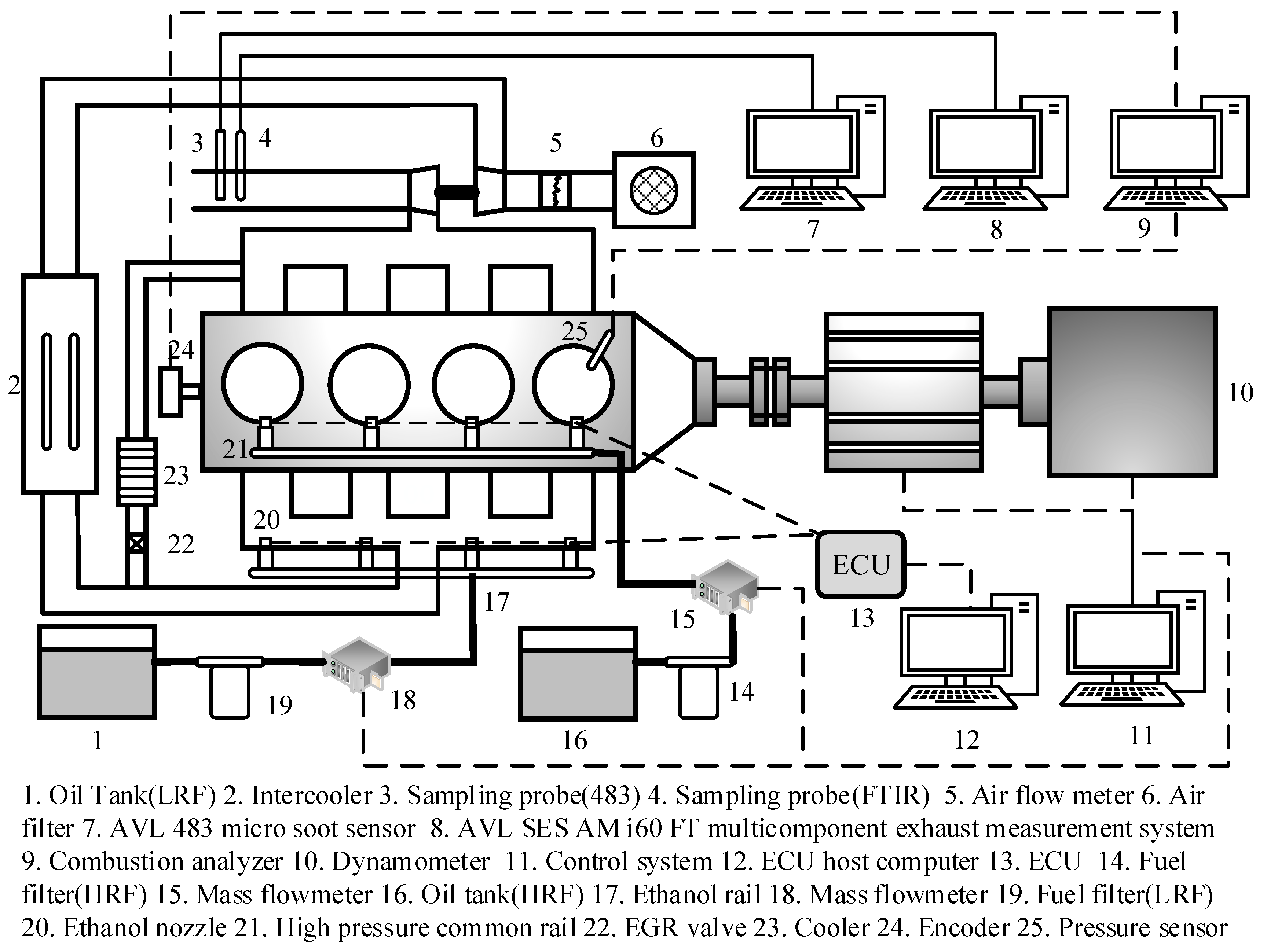

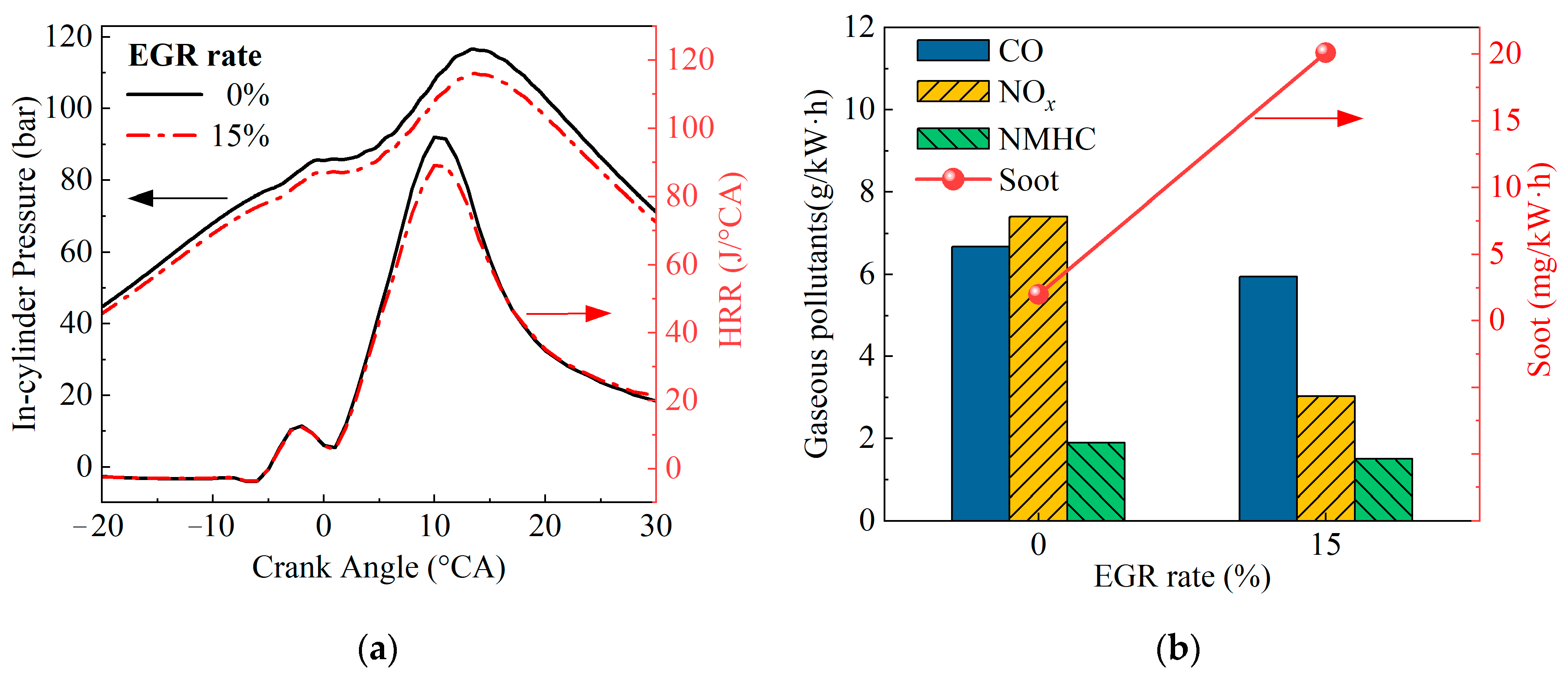

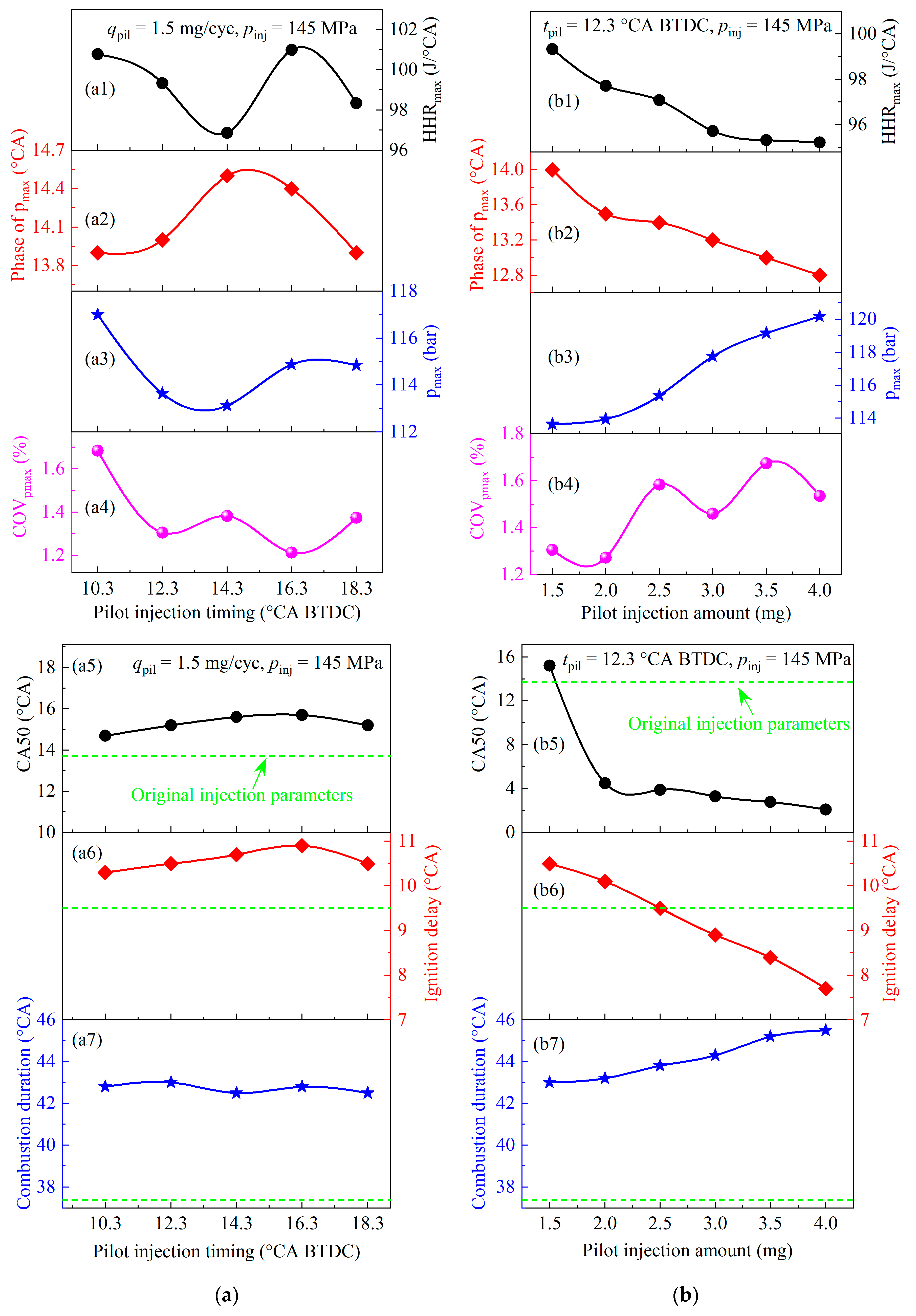
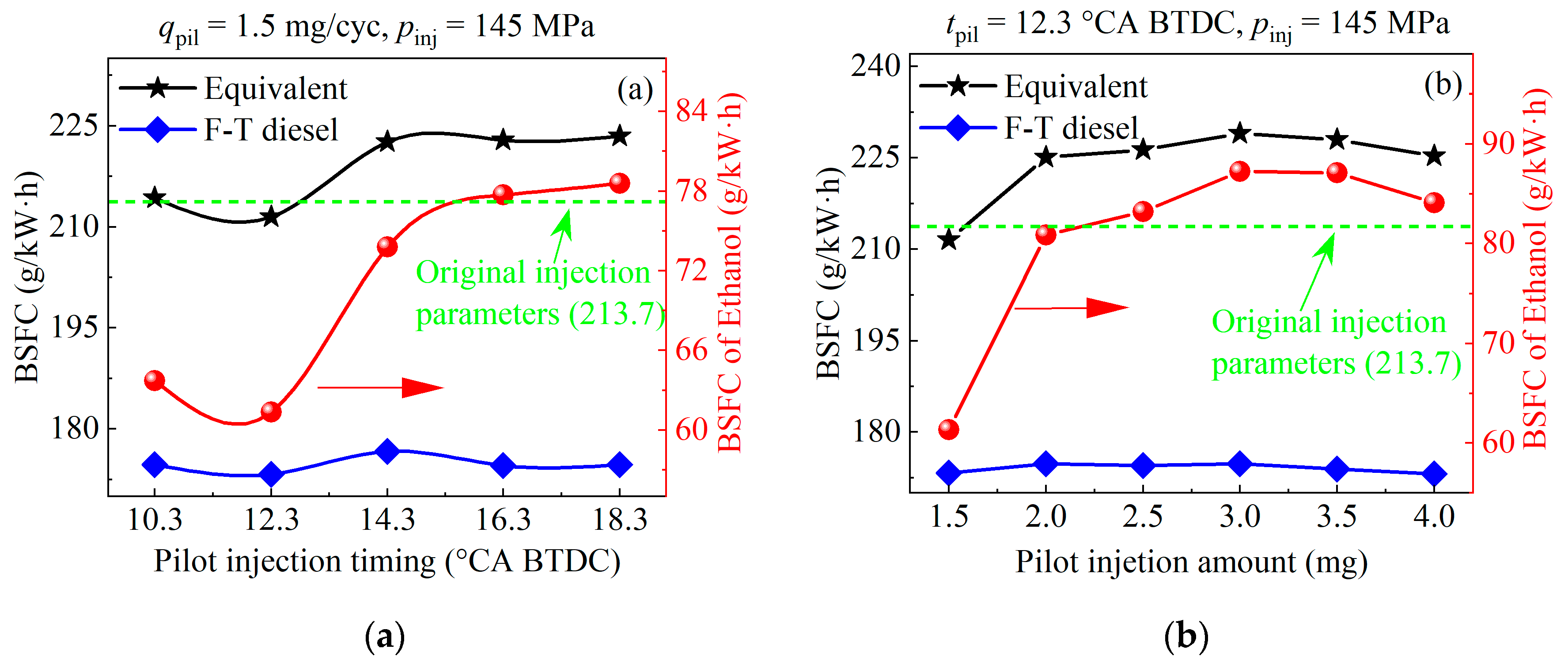

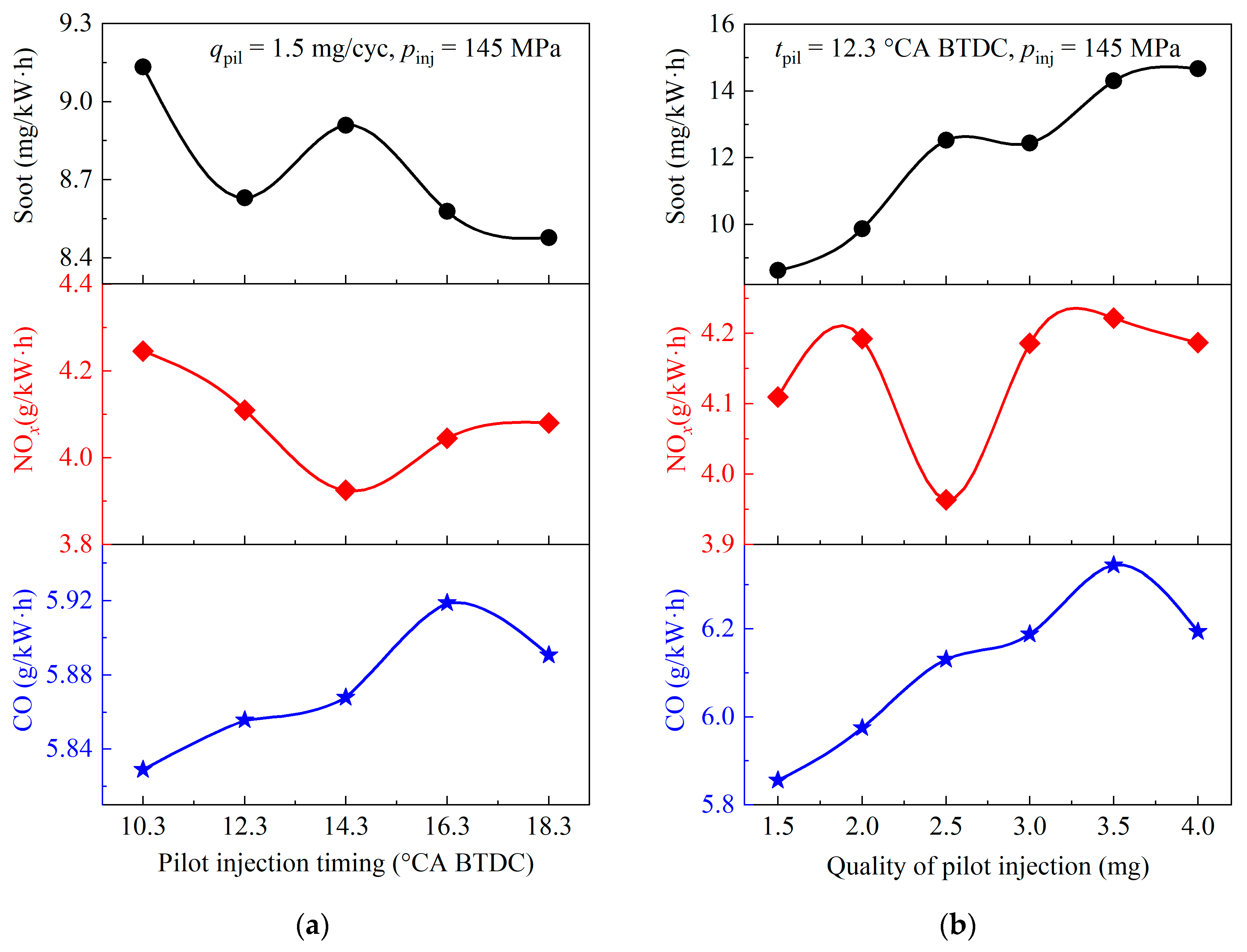
| Items | Values |
|---|---|
| Cylinder number | 4 |
| Bore (mm) | 92 |
| Stroke (mm) | 94 |
| Displacement (L) | 2.499 |
| Compression ratio | 16.6:1 |
| Rated power speed (r·min−1) | 3200 |
| Rated power (kW) | 85 |
| Measured Parameters | Unit | Range | Accuracy |
|---|---|---|---|
| Engine speed | r·min−1 | 0~8000 | ±0.1% F.S |
| Engine torque | N·m | 0~500 | ±1% F.S |
| Cylinder pressure | bar | 0~250 | ±0.005 |
| F-T diesel mass flowmeter | kg/h | 0~250 | 0.2% F.S |
| Ethanol mass flowmeter | kg/h | 0~40 | 0.1% |
| NOx | 10–6 | 0~10,000 | ±1.5 |
| CO | 10–6 | 0~10,000 | ±1.2 |
| Soot | mg/m3 | 0.001 to 50 | ±0.005 |
| Parameters | 0# Diesel [13] | F-T Diesel [37] | Ethanol |
|---|---|---|---|
| Density at 25 °C (g/cm3) | 0.81 | 0.757 | 0.789 |
| Cetane number | 55.8 | 74.8 | 6 |
| Research octane number | - | - | 111 |
| Low heating value (MJ/kg) | 42.65 | 43.07 | 26.79 |
| Heat of vaporization (kJ/kg) | 260 | - | 847 |
| Oxygen fraction (mass%) | 0 | 0 | 34.8 |
| Stochiometric air/fuel ratio | 14.3 | 14.96 | 9.0 |
| Parameters | qpil (mg/cyc) | tpil (°CA BTDC) | Main Injection Timing (°CA BTDC) | Period between the End of Pilot Injection and the Start of Main Injection (°CA) |
|---|---|---|---|---|
| Fixed qpil | 1.5 | 10.3 | 5.6 | 1.8 |
| 12.3 | 3.8 | |||
| 14.3 | 5.8 | |||
| 16.3 | 7.8 | |||
| 18.3 | 9.8 | |||
| Fixed tpil | 1.5 | 12.3 | 5.6 | 3.8 |
| 2.0 | 3.7 | |||
| 2.5 | 3.6 | |||
| 3.0 | 3.5 | |||
| 3.5 | 3.4 | |||
| 4.0 | 3.3 |
Disclaimer/Publisher’s Note: The statements, opinions and data contained in all publications are solely those of the individual author(s) and contributor(s) and not of MDPI and/or the editor(s). MDPI and/or the editor(s) disclaim responsibility for any injury to people or property resulting from any ideas, methods, instructions or products referred to in the content. |
© 2023 by the authors. Licensee MDPI, Basel, Switzerland. This article is an open access article distributed under the terms and conditions of the Creative Commons Attribution (CC BY) license (https://creativecommons.org/licenses/by/4.0/).
Share and Cite
Yang, T.; Chen, D.; Liu, L.; Zhang, L.; Wang, T.; Li, G.; Chen, H.; Chen, Y. Effect of Pilot Injection Strategy on Performance of Diesel Engine under Ethanol/F-T Diesel Dual-Fuel Combustion Mode. Processes 2023, 11, 1919. https://doi.org/10.3390/pr11071919
Yang T, Chen D, Liu L, Zhang L, Wang T, Li G, Chen H, Chen Y. Effect of Pilot Injection Strategy on Performance of Diesel Engine under Ethanol/F-T Diesel Dual-Fuel Combustion Mode. Processes. 2023; 11(7):1919. https://doi.org/10.3390/pr11071919
Chicago/Turabian StyleYang, Tiantian, Dongdong Chen, Lei Liu, Longyan Zhang, Tie Wang, Guoxing Li, Haiwei Chen, and Yao Chen. 2023. "Effect of Pilot Injection Strategy on Performance of Diesel Engine under Ethanol/F-T Diesel Dual-Fuel Combustion Mode" Processes 11, no. 7: 1919. https://doi.org/10.3390/pr11071919
APA StyleYang, T., Chen, D., Liu, L., Zhang, L., Wang, T., Li, G., Chen, H., & Chen, Y. (2023). Effect of Pilot Injection Strategy on Performance of Diesel Engine under Ethanol/F-T Diesel Dual-Fuel Combustion Mode. Processes, 11(7), 1919. https://doi.org/10.3390/pr11071919







